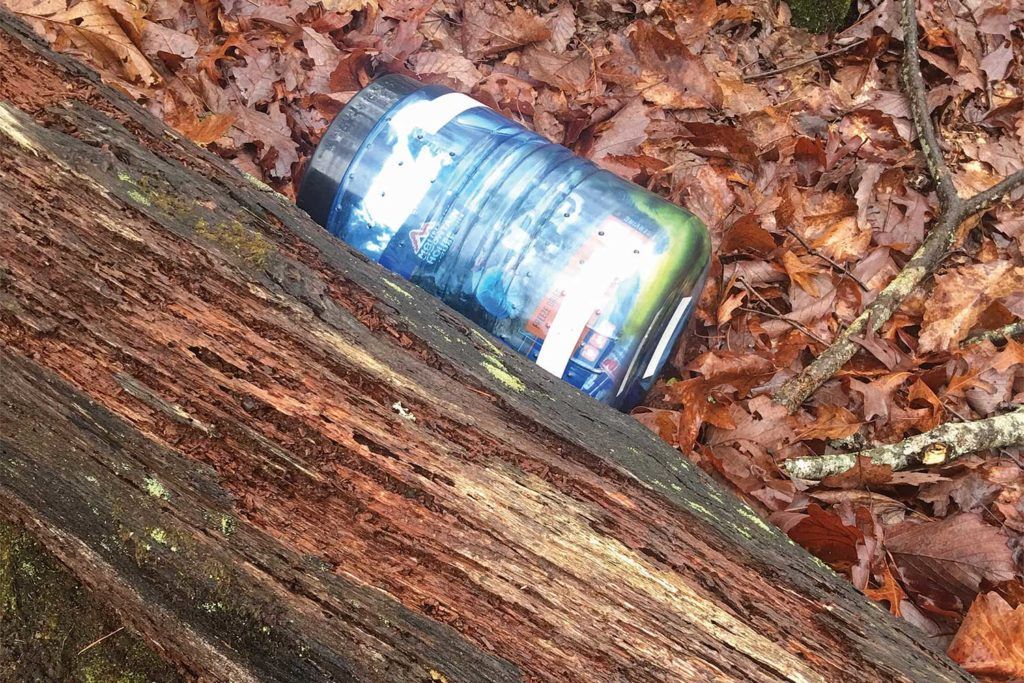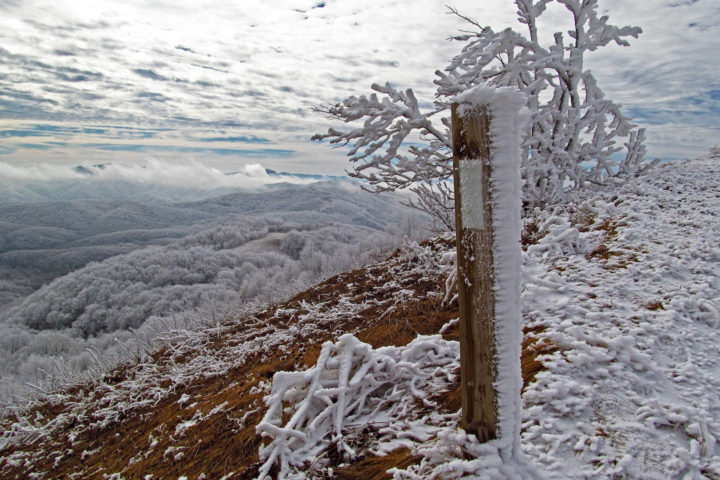By David McDowell Schafer
Harmful Habits
Campsite 113 is the first overnight site that northbound A.T. thru-hikers reach when they enter the Great Smoky Mountains National Park. As a ridgerunner in the Smokies, part of my duty is the maintenance of sites like 113. For many hikers, it serves as a spot for a short lunch break, or one of countless overnight stays on their long journey north. Humans, however, are not the only frequenters of the site. During my three-month season, I encountered the same mother bear and her cub at campsite 113 no less than ten times. They became a feature, a constant. I would yell and throw rocks until they ran away, but without fail they would be there the next time I visited the site.
It was obvious these bears were habituated to humans. A wild bear, or other wild animals, will run away at the first sight of a hiker. But this mother bear and her cub couldn’t care less when I came along, until I yelled at them. It was likely that the mother had received some sort of food reward from the area. Maybe food scraps leftover from a messy meal, or errant overnight storage that yielded a bounty of calorie-rich treats.
Safe food storage goes far beyond protecting you and your sustenance
It is important to remember we use these methods not just to protect our food and ourselves, but to protect the animals that inhabit the A.T. Wild East.
She was teaching her cub the same behavior: come to this site and you might find something delicious. Behavior like this reminds us why proper food storage is a key skill for backpackers on the A.T. Each hiker you meet will likely have a different strategy than the next. Not all methods, however, are equal. With that in mind, what storage methods are best and help protect wildlife and keep it healthy and behaving naturally?
The Methods
The bear hang is probably the most well-known and the most commonly used (but most unreliable) form of food storage among hikers. Put simply, a bear hang is the use of rope, a carabiner, and a stuff sack to hang your food in a tree, away from the reach of bears and other critters. However, a poorly made bear hang serves as an easy meal for local wildlife. Many campsites lack the proper trees, and the typically poor execution of a bear hang by hikers makes this a problematic form of storage. Bears in particular are smart and adaptive, so eventually even the best hang will likely be defeated. Because of the bear hang’s frequent failures along the A.T., the Appalachian Trail Conservancy highly recommends that hikers use bear canisters as their form of food storage.
A bear canister is one of the most foolproof methods of food storage. There are many varieties of canisters, but their designs are generally the same: a hard-sided, cylindrical container with a locking mechanism to prevent critters from accessing your delicious snacks. They are easy to operate, can be left on the ground overnight, and require none of the same fuss that a bear hang does. Many hikers appreciate bear canisters for their ease of use and greater security over bear hangs. However, they are heavier than a bear hang kit and bulky, making them a hard sell to hikers who are focused on lightweight gear and a small pack. Land management supervisors in North Carolina are close to ratifying food storage regulations for the A.T. that will require the use of hard-sided canisters. Whether hikers like them or not, canisters may soon become the de facto storage method for the A.T. in most of the southeast, as well as in Vermont’s Green Mountains.
The Ursack is a product that tries to allay the disadvantages of a bear canister while providing a similar level of ease of use. An Ursack is a soft-sided container made of Spectra, or Spectra and Kevlar, depending on the model. This fabric is resistant to punctures from bears, is lighter than a canister, and packs more easily due to its collapsible nature. An Ursack is secured using a series of knots to seal the sack closed and then tie it to a tree. It typically is less fuss than a bear hang, but is more work than a canister. A disadvantage of the Ursack is that its contents may be crushed by a bear and any food may become inedible. Most importantly, Ursacks are not a replacement for canisters in jurisdictions that require them. The regulations that may soon pass in the national forests in North Carolina do not include language that allows for an Ursack. The Great Smoky Mountains National Park, while partially in North Carolina, will not be affected by the U.S. Forest Service regulations. Agency-installed bear cables are still the required system of food storage in the Smokies.
It is important to note that some overnight sites on the A.T. have infrastructure for food storage already in place, similar to the Smokies. Bear cables, boxes, and poles are the most common permanent fixtures used at shelters. These are suitable options for hikers who make use of the shelters and they increase the safety and appeal of the sites themselves. Campers should not expect one of these at every site, however. Only about 40 percent of A.T. overnight sites have food storage devices installed. Because of their infrequency, permanent food storage fixtures should not be relied upon, and campers should still carry their own form of food storage at all times.
Lastly, some campers will sleep with their food, although not many are willing to admit it. This is an irresponsible and dangerous method for the A.T. Sleeping with one’s food habituates animals to shelters and tents and greatly increases the likelihood of a mutually negative encounter with wildlife. It is one of the reasons that mice are a problematic and universal experience in the shelters along the Trail. A hiker that slept with their food at a shelter or campsite on a previous night trains nearby critters to investigate that area in the future. When animals become habituated, it is possible you may have a late-night visitor looking for an easy reward, even if you do not have food in your sleep space. Additionally, the habituation of mice to shelters can attract other unwanted visitors. Snakes — both venomous and non-venomous — will eat the mice that live in the shelters, thus creating more unnecessary and dangerous encounters with humans. Hikers are always on the move, sometimes at the expense of the places they leave behind. Shelters, campsites, and the animals that live nearby are static. One site could have the same wildlife visitor many times over, just like the bears I saw at Campsite 113.

A bear canister is one of the most foolproof methods of food storage – By Morgan Sommerville
The Reasons
In the sometimes long-winded discussions around backcountry food storage, it is important to remember we use these methods not just to protect our food and ourselves, but to protect the animals that inhabit the A.T. Wild East. Black bears are typically crepuscular, meaning they are most active during dawn and dusk. Mice are nocturnal, which is why hikers always hear them scurry around the shelter as soon as the last headlamp goes out. Less frequently encountered critters such as raccoons, skunks, and porcupines are also nocturnal and can be just as negatively affected by poor food storage. These creatures, among many others that are active at night, make up an often unseen and unheard ecosystem. They come out when we humans are the least active: sound asleep, still groggy before our morning coffee, or exhausted after a long day of hiking.
Taking the time to protect our food when we’re in our most dormant states helps nocturnal creatures thrive when they are the most active. When given the choice of foraging for food, or taking an easy meal due to human error, an animal will always go for the easy meal. Habituation helps animals overcome their natural wariness of people, which can lead to aggressive and destructive behavior. When humans and animals come in conflict, animals ultimately lose. Proper food storage is not just for yourself, it’s for the hiker behind you, and it’s especially for the wildlife that lives nearby. We are, after all, only visiting.
Discover More

By Jennifer Pharr Davis
Scenic Views
Wide-open vistas beyond the footpath offer respite and are essential to the Wild East.

Hiking Tips
What to Know Before You Go
Wide-open views, crisp air and solitude make for a cool hike, but when winter hiking, being prepared is key.

Where to Hike
Our Favorites for a Winter Adventure
These hikes are not only enjoyable, but also safe for a colder day





